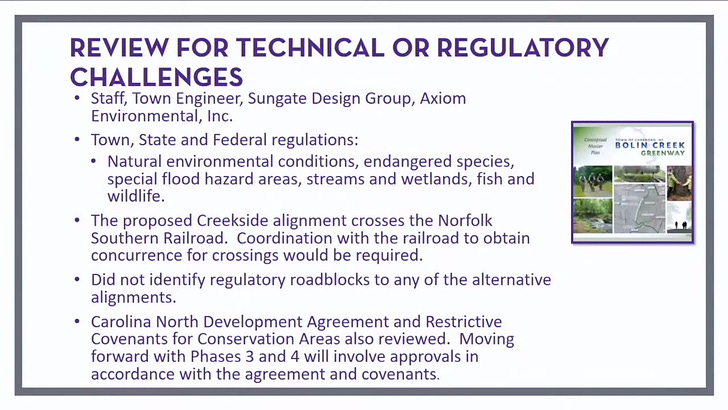Ignoring the Facts: Carrboro's Council Faces Backlash Over Disregarded Technical Report
Ignoring the Facts: Carrboro's Council Faces Backlash Over Disregarded Technical Report
At its October 17 meeting, the Carrboro Town Council voted to move forward with the controversial creekside alignment known as Bolin Creek Greenway phases III and IV. That evening before the vote, Carrboro Planning Director Trish McGuire referenced a technical review document by Sungate Design Group and stated that no regulatory barriers were found.
Upon learning about the technical report, a local non-profit, Friends of Bolin Creek, requested a copy from the town clerk, which included details about regulatory barriers not shared during McGuire's presentation. You can view the presentation by clicking here:
Mayor Seils and Town Council members Romaine, Posada, Slade, Nowell, and Foushee voted 6-1 in favor of the creekside alignment; Randee Haven-O’Donnell was the sole dissenting council member. Upon learning of the report, Haven-O’Donnell ordered and received a copy on November 29, but it was not delivered to the other council members by the interim clerk, Ms. Welsh, until Wednesday, 12/01.
The Sungate Technical Review confirms nearly all of the original arguments against creekside paving contained in the petition sent to the Town Council by Keep Bolin Wild. Most importantly, it reiterates that state law only allows paving within the 50 foot riparian buffer when no practical alternative is available. It also notes that the bridges incorporated in the 2009 design plan are not compliant with the ADA No Rise requirements. Because the proposed site of the greenway is in a floodplain, bridges must be a certain height which makes satisfying the ADA requirements for No Rise difficult if not impossible to achieve.
Also mentioned in the report is the “extensive time” it would take to obtain permitting for pedestrian crossing of Norfolk Southern Railroad and that a considerable portion of the trail would also traverse privately owned land, which could pose a “significant risk” to the project.
At the town meeting on November 29 where the Council was to vote on projects to include in a request for state transportation funding, Council Member Haven-O’Donnell, who has consistently raised concerns about the lack of current scientific data or updated environmental and feasibility studies both before and during the October 17 vote, shared her concern that Council was not apprised of the technical report, nor had it been disseminated to members or discussed in advance of choosing the creekside alignment.
Martha Hoelzer, the newly elected President of Friends of Bolin Creek, addressed the Council that same evening and also pointed out that the report dated September 28 was not made available to the public and though the town planner cited no regulatory barriers, she mentioned two including the decision to move ahead with planning and potentially building the greenway before OWASA has begun sewer line replacement that is not scheduled for completion until 2029– which would require removing and repaving the greenway.
Mayor Seils defended the decision to approve the creekside alignment and suggested that the town planner meant that there were no "new" regulatory barriers, and that he was aware of the Jordan Lake Rules, but considered these to be ordinary hurdles such as the ones Chapel Hill faced when paving next to the creek over twenty years ago.
The report, however, does state that, “due to the age of the conceptual master plan, water quality buffers and associated impacts are not discussed in the plan.” Environmental knowledge has changed significantly over the last twenty years and cities like Cary and Raleigh have begun shifting greenways away from delicate wetlands for both environmental and economic reasons since this conceptual plan was designed.
Had this report been made available earlier, it would have provided valuable information for community members who may have requested an extended engagement process as it specifically debunks the false claim that paving prevents creek erosion– a myth that is repeated on social media and the blogs of people who desire a recreational bike path for their neighborhoods.
Contrary to armoring the creek with concrete, the technical review specifically recommends moving the trail fifty feet or more away from the creek and out of the floodplain so the creek can evolve without impacting the greenway. In many places the OWASA corridor is not wide enough to achieve this. There are alternative routes that are investment ready, such as the Seawell School Sidepath, but they weren’t included for analysis even though they could be developed more affordably without harming the forest or Bolin Creek. A path along Seawell could also be constructed using alternative natural materials such as crushed stone rather than concrete which is also recommended in the report.
Regardless of the specific wording of “new” or “old” regulations, what is more consequential is this challenge for the Carrboro Council: the imperative to present and review all pertinent information before pivotal votes. Presently, there seems to be a focus on transportation so narrow that it leaves little, if any, room for other crucial environmental concerns such as maintaining clean water access for all, addressing heightened flooding risks due to climate change, and mitigating habitat loss caused by human encroachment—issues that are very important to the health of our citizens.
We now find ourselves at a critical crossroads where we must urge not only better environmental stewardship for a habitable planet, but also government transparency and a willingness to listen to scientists and experts. Now that the council members have received the report, will they heed its advice and be open to the alternatives that have been suggested? We strongly urge all Carrboro citizens to attend your next local council meeting to find out.
You can read the full technical report, here:
As always, thanks for reading and Stay Wild, Y’all!
Oh, and please like, share and subscribe!




